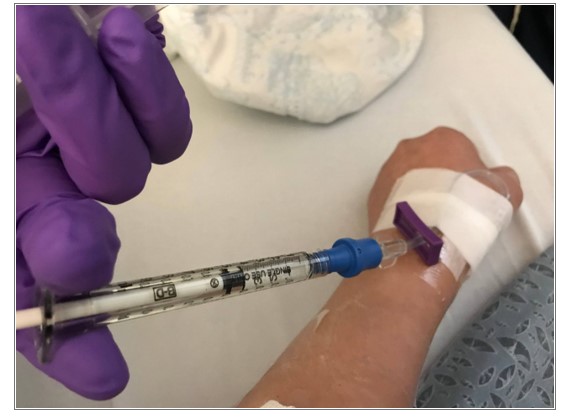A client has undergone a surgical procedure and develops a weak, rapid pulse.
Which intervention should the nurse recommend to provider during their SBAR communication?
Anticholinergic.
Urinary catheter placement.
Beta blocker.
Intravenous fluid bolus.
The Correct Answer is D
A weak, rapid pulse indicates that the client is experiencing hypovolemia or low blood volume due to blood loss during surgery.
The nurse should recommend to the provider to administer intravenous fluids to restore the client’s circulating volume and improve their hemodynamic status.
Choice A is wrong because anticholinergics are drugs that block the action of acetylcholine, a neurotransmitter that stimulates the parasympathetic nervous system.
Anticholinergics can cause tachycardia, dry mouth, urinary retention, and blurred vision. They are not indicated for hypovolemia.
Choice B is wrong because urinary catheter placement is not a priority intervention for a client with hypovolemia.
Urinary catheterization can help monitor urine output and renal perfusion but does not address the underlying cause of low blood volume.

Choice C is wrong because beta blockers are drugs that block the action of epinephrine and norepinephrine, neurotransmitters that stimulate the sympathetic nervous system.
Beta-blockers can lower blood pressure, heart rate, and cardiac output.
They are not indicated for hypovolemia and can worsen the client’s condition.
To communicate this information using the SBAR tool, the nurse should follow these steps: Situation: Identify yourself, the client, and the problem.
For example: “I am (name), the nurse caring for (client name) in room (number).
I am calling because I am concerned that the client has developed hypovolemia after surgery.”
Background: Provide relevant and brief information related to the situation.
For example: “The client had a surgical procedure (name and type) at (time) today. They have lost (amount) of blood during and after surgery.
Their current vital signs are: blood pressure (value), pulse (value), respiratory rate (value), temperature (value), oxygen saturation (value).”
Assessment: Share your analysis and considerations of options. For
Nursing Test Bank
Naxlex Comprehensive Predictor Exams
Related Questions
Correct Answer is A
Explanation
A 37-year-old who has insulin-dependent diabetes mellitus has the greatest need for special mouth care. This is because diabetes can affect the blood vessels and nerves in the mouth, leading to dry mouth, gum disease, infections, and delayed healing. Special mouth care for this client would include regular brushing and flossing, using a soft toothbrush or foam brush, rinsing with water or saline, checking for signs of inflammation or infection, and avoiding sugary or acidic foods and drinks.
Choice B is wrong because a 58-year-old who wears dentures does not have a greater need for special mouth care than a diabetic client.
Dentures can be removed and cleaned with a soft toothbrush and denture cleaner, and soaked overnight in a denture solution. The gums and mouth should also be cleaned daily with a soft toothbrush or gauze.
Choice C is wrong because a 26-year-old who is on bed rest does not have a greater need for special mouth care than a diabetic client. Bed rest can cause dry mouth and plaque accumulation, but these can be prevented by regular brushing and rinsing, drinking water frequently, and using sugar-free gum or lozenges.
Choice D is wrong because a 45-year-old who is NPO (nothing by mouth) does not have a greater need for special mouth care than a diabetic client. NPO can cause dry mouth and bad breath, but these can be alleviated by regular rinsing with water or saline, applying water-based lip balm or moisturizer, and using artificial saliva products if needed.
Correct Answer is D
Explanation
. Document the findings and continue to monitor the wound. This is because a 2-day-old wound that has a crust along the edges, is red and appears slightly swollen is likely in the inflammatory phase of wound healing. This phase is characterized by hemostasis, chemotaxis, and increased vascular permeability, which can
cause redness and swelling. The crust along the edges is formed by the clotting of blood and platelets.
These are normal signs of wound healing and do not indicate infection or complications.
Choice A is wrong because applying warm soaks to reduce inflammation can interfere with the natural process of wound healing and increase the risk of infection.
Choice B is wrong because notifying the health care provider immediately of the infection is not necessary unless there are other signs of infection such as fever, pus, foul odor, or increased pain.
Choice C is wrong because placing the client on contact (wound) precautions is not required for a 2-day-old wound that is not infected or draining. Wound precautions are only indicated for wounds that are colonized or infected by multidrug-resistant organisms.
Whether you are a student looking to ace your exams or a practicing nurse seeking to enhance your expertise , our nursing education contents will empower you with the confidence and competence to make a difference in the lives of patients and become a respected leader in the healthcare field.
Visit Naxlex, invest in your future and unlock endless possibilities with our unparalleled nursing education contents today
Report Wrong Answer on the Current Question
Do you disagree with the answer? If yes, what is your expected answer? Explain.
Kindly be descriptive with the issue you are facing.
